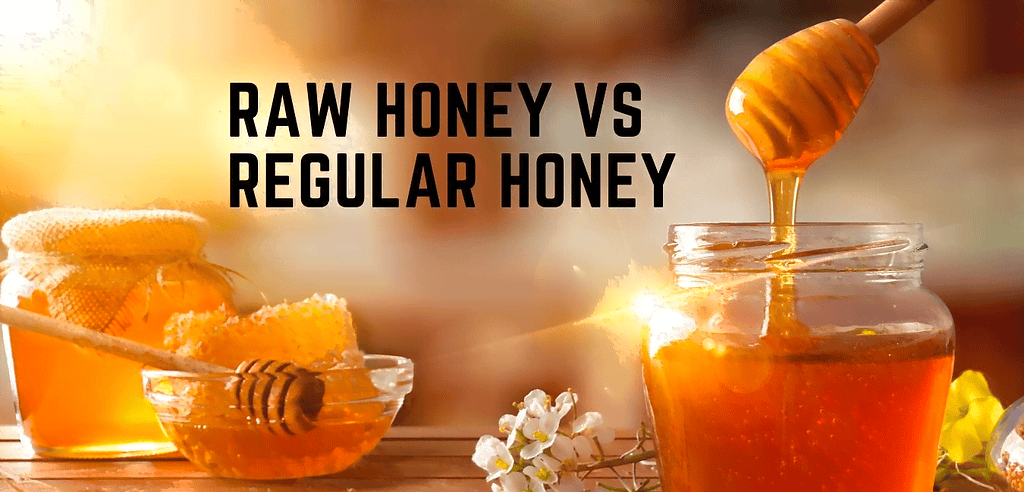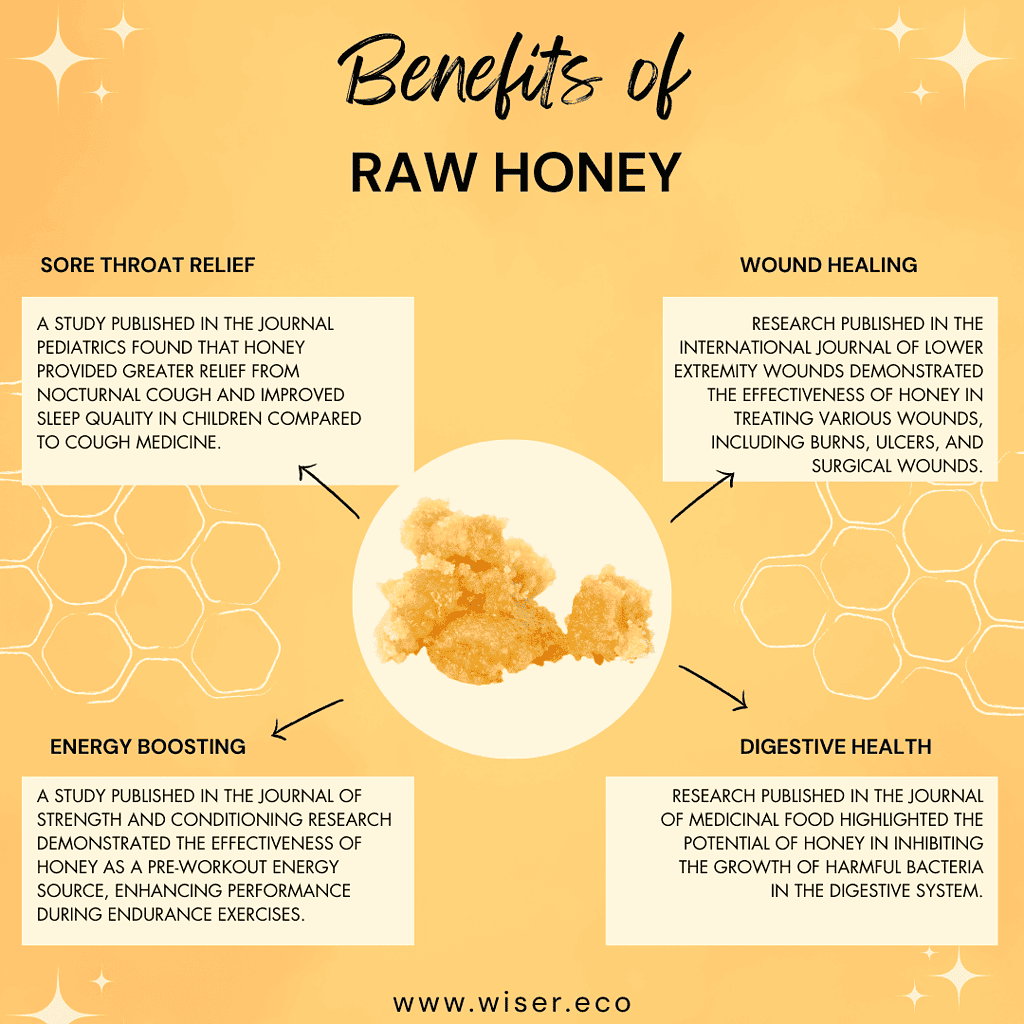Raw honey and regular honey are two popular choices in the world of sweeteners, but what sets them apart? Raw honey is straight from the hive, unfiltered and unpasteurized, while regular honey undergoes processing. This process removes impurities and gives it a smoother consistency. However, it also strips away some of the beneficial enzymes, antioxidants, and nutrients found in raw honey. In this article, we delve into the differences between raw honey and regular honey, exploring their production methods, health benefits, and culinary uses. By understanding these distinctions, you can make an informed choice when selecting honey for your needs.

What is Raw Honey?
Raw honey is a pure and unprocessed form of honey that comes straight from the beehive. It is collected by extracting honeycombs from the hive and straining them to remove any impurities, like beeswax or bee parts while preserving their natural qualities. Unlike regular honey, raw honey doesn’t undergo pasteurization, filtration, or heating procedures.
Raw honey is known for its rich and robust flavor, along with its thick and sometimes crystallized texture. It contains a variety of beneficial components that are often lost in the processing of regular honey, including pollen, enzymes, vitamins, minerals, and antioxidants.
Due to its unaltered nature, raw honey is believed to offer a range of health benefits. It is commonly used as a natural remedy for soothing sore throats, alleviating allergies, boosting the immune system, and promoting digestive health. Some people also use raw honey topically for skincare purposes.
However, it’s important to note that raw honey may pose a risk for infants under one year old. The AAP advises against feeding honey to infants under one year old due to the risk of infant botulism, which is caused by the bacteria Clostridium botulinum. This bacteria can be present in raw honey and can lead to serious illness in infants. It is always recommended to consult with a healthcare professional before introducing honey to young children or if you have any specific health concerns.
Difference Between Raw Honey vs Honey
Raw honey and regular honey are distinct types of honey that vary in processing methods, nutritional composition, flavor profiles, and potential health advantages. Understanding the differences between raw honey and regular honey can help you make an informed choice when selecting honey for your needs.

Processing
- Raw Honey
Raw honey is obtained straight from the beehive and undergoes minimal processing. It is extracted from the honeycombs and then strained to remove impurities such as beeswax and bee parts. Raw honey is not subjected to pasteurization, filtration, or heating processes, allowing it to retain its natural enzymes, pollen, vitamins, and minerals.
- Regular Honey
Regular honey, also known as processed or commercial honey, undergoes various processing steps. It is typically heated and filtered to remove impurities and achieve a smoother texture. The heating process helps delay crystallization and improves shelf life. However, this process can also destroy some beneficial enzymes, vitamins, and antioxidants present in the honey.
Texture and Appearance
- Raw Honey
Raw honey often has a thick consistency and may appear cloudy or contain particles such as pollen or honeycomb remnants. Over time, raw honey may naturally crystallize, forming granules. This crystallization is a natural process and does not affect the quality or taste of the honey. If desired, raw honey can be gently warmed to restore its liquid state.
- Regular Honey
Regular honey is typically clear and has a smooth, syrup-like texture. The processing steps, including heating and filtration, give it a more refined appearance compared to raw honey. Regular honey is less prone to crystallization because of the removal of pollen and other particles during filtration.
Flavor and Aroma
- Raw Honey
Raw honey often possesses a robust and distinct flavor profile that can vary depending on the nectar sources and the region where it was harvested. It may have floral, fruity, or herbal notes and can exhibit different nuances of taste. Some people appreciate the complexity and depth of flavors found in raw honey.
- Regular Honey
Regular honey has a milder and more consistent flavor profile compared to raw honey. The removal of pollen and other particles during these processes contributes to a smoother and more consistent taste profile in regular honey.
Nutritional Content
- Raw Honey
Raw honey is known to be rich in beneficial components that may be diminished or lost during processing. It contains enzymes, pollen, vitamins (such as vitamins C and B vitamins), minerals (such as iron and potassium), and antioxidants. Raw honey also keeps traces of bee propolis and bee pollen, which have been associated with potential health benefits.
- Regular Honey
While regular honey still retains some nutritional value, the processing it undergoes can reduce its content of enzymes, pollen, and antioxidants. The extent of nutrient loss may vary depending on the processing methods used. However, regular honey remains a source of carbohydrates and provides sweetness in culinary applications.
Potential Health Benefits
- Raw Honey
Raw honey has been traditionally used for its potential health benefits. It is believed to have antimicrobial properties and may help soothe sore throats, coughs, and minor wounds. Raw honey may also possess anti-inflammatory and antioxidant properties. Some people use raw honey to support digestive health, alleviate allergies, or as a natural energy booster. However, it’s important to note that scientific evidence supporting these health claims is limited, and individual results may vary.
- Regular Honey
Like raw honey, regular honey can provide soothing effects for sore throats and coughs because of its viscous nature. However, regular honey may have lower levels of certain beneficial compounds compared to raw honey, potentially reducing its potential health benefits.
It’s important to remember that honey, whether raw or regular, is still sugar and should be consumed in moderation. It is not recommended for infants under one-year-old due to the risk of botulism spores that may be present in raw honey.
The Use Of Raw Honey In Traditional Medicine And Natural Remedies
Raw honey has a long history of use in traditional medicine and natural remedies. It has been valued for its potential health benefits and therapeutic properties. Here are some common uses of raw honey in traditional medicine.

- Sore Throat Relief
Raw honey is known for its soothing properties, making it a popular remedy for sore throats. Its viscous texture provides a coating effect, helping to alleviate discomfort and reduce irritation.
- Cough Suppressant
Honey has been used as a natural cough suppressant for centuries. Its sticky consistency helps to soothe the throat and suppress coughing. Raw honey can be taken directly or added to warm water or herbal teas for relief.
- Wound Healing
Raw honey has antimicrobial properties and may aid in wound healing. It can be applied topically to minor cuts, burns, or abrasions to help clean the wound, prevent infection, and promote healing. Its natural enzymes and antioxidants may also contribute to tissue regeneration.
- Allergy Relief
Some people use raw honey as a natural remedy for seasonal allergies. The theory behind this is that local honey contains traces of pollen from local plants, which can help desensitize the body to pollen allergens. However, scientific evidence supporting this claim is limited, and individual results may vary.
- Digestive Health
Raw honey has been used to support digestive health and alleviate certain gastrointestinal issues. It is believed to have antibacterial properties that may help combat harmful bacteria in the digestive system. Some people also use raw honey to relieve symptoms of indigestion, such as bloating and stomach discomfort.
- Energy Booster
Raw honey is a natural source of carbohydrates, providing a quick energy boost. Its natural sugars, including glucose and fructose, are easily digested and absorbed by the body, making it an effective natural energy source.
It’s important to note that while raw honey has been traditionally used in these remedies, scientific research is ongoing, and not all claims have been fully supported by clinical studies. Individual responses to honey may vary, and it is recommended to seek advice from a healthcare professional before using raw honey as a remedy, particularly if you have specific health conditions or are currently taking medications.
It’s crucial to ensure the honey you use is sourced from reliable and reputable sources to minimize the risk of contamination or adulteration. Due to the potential presence of botulism spores, it is advised not to give raw honey to infants under the age of one year.
The Price Differences Between The Two Types Of Honey
The price differences between raw honey and regular honey can vary depending on several factors, including the quality, sourcing, and availability of the honey. Here are some general considerations.
- Production Process
Raw honey requires minimal processing, which means it undergoes fewer steps and keeps more of its natural components. This can make raw honey slightly more expensive compared to regular honey, which often undergoes more extensive processing and filtration.
- Sourcing and Availability
The availability of raw honey can vary depending on the region and local beekeeping practices. If raw honey is sourced from specific nectar sources or rare honeybee species, it may be relatively more expensive because of limited supply and higher demand. Regular honey is more widely available and can be produced in larger quantities, which may contribute to lower prices.
- Certification and Quality
Some raw honey may be certified organic or come from specific sources known for their high-quality standards. These certifications and quality designations can impact the price, as they often require stricter production practices and quality control measures.
- Packaging and Branding
The packaging, branding, and marketing efforts of honey producers can also influence the price of both raw and regular honey. Premium packaging, unique branding, and promotional activities can contribute to higher prices.
It’s important to note that the price difference between raw honey and regular honey is not solely indicative of quality or nutritional value. While raw honey may retain more natural components, regular honey can still provide sweetness and serve culinary purposes. The choice between the two types of honey ultimately depends on personal preferences, desired flavors, and intended uses.
Final Word
In conclusion, the differences between raw honey and regular honey lie in their processing, texture, flavor, nutritional content, and potential health benefits. Raw honey is minimally processed, keeps more natural enzymes, pollen, and antioxidants, and offers a diverse flavor profile. Regular honey undergoes processing steps such as heating and filtration, resulting in a smoother texture and a milder, more consistent flavor. Both types of honey have their merits and can be enjoyed for their unique qualities.
When choosing between raw honey and regular honey, consider factors such as personal taste preferences, desired flavors, and any specific health considerations. Raw honey is often favored for its potential therapeutic properties, including sore throat relief, wound healing, and digestive support. However, it’s important to note that scientific evidence supporting these health claims is limited, and individual responses may vary. Ultimately, the choice between raw honey and regular honey depends on personal preference and individual considerations.
Whether you opt for the unique characteristics of raw honey or the familiar taste of regular honey, your decision can contribute to a more sustainable and bee-friendly world. Make a sustainable choice today and shop at Ecowiser for eco-friendly products that align with your values. Join the eco-wise movement today and make sustainable choices for a better future.








